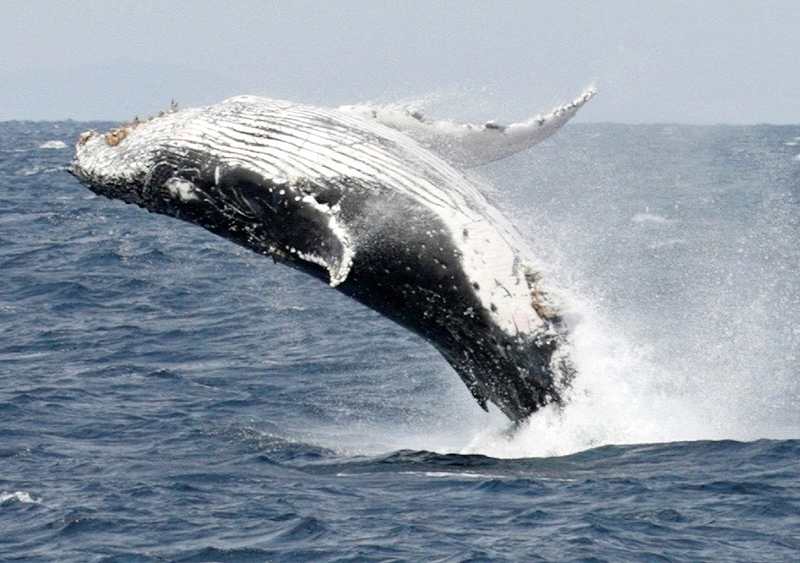
A humpback whale breaches off Okinawa Island in February 2007.
17:51 JST, December 1, 2022
WASHINGTON (Reuters) — As Earth’s largest animals, blue whales are mighty big eaters, gulping tons of food each day. They also now are ingesting huge amounts of plastic, according to scientists, due to the alarming volume of tiny particles of pollution choking the oceans.
Researchers on Nov. 1 presented an estimate of the amount of microplastics ingested by three species of baleen whales — blue, fin and humpback — off the U.S. Pacific coast, detailing an issue posing uncertain health concerns for these marine mammals.
As baleen whales, these species are filter-feeders. They strain food — shrimp-like crustaceans called krill and other small prey — from the seawater using baleen plates in the mouth made of keratin, the substance found in people’s fingernails.
Blue whales, according to the study, may swallow roughly 10 million microplastic pieces daily, or up to about 43.5 kilograms of plastic. For fin whales, whose main prey also is krill, the estimated daily tally is about 6 million microplastic pieces, or up to 26 kilograms of plastic.
Some humpback whales specialize in krill and some favor eating small, schooling fish. Krill-favoring humpbacks, according to the study, may ingest about 4 million microplastic pieces (up to 17 kilograms of plastic) daily, while those favoring fish may take in a much smaller amount, roughly 200,000 pieces (around a kilogram of plastic).
“In the moderately polluted waters off the U.S. West Coast, baleen whales may still be ingesting millions of microplastics and microfibers per day,” said Stanford University marine biologist Matthew Savoca, a coauthor of the study published in the journal Nature Communications.
“Also we find that the vast majority — 99% — are via their prey that have previously ingested plastic and not from the water they filter,” Savoca added.
The study illustrated how baleen whales may be at an elevated risk for microplastics ingestion as a result of their mode of feeding, the quantity of their food intake, and their habitat overlapping with polluted areas such as the California Current that flows south along North America’s western coast.
Blue whales can reach a maximum of about 30 meters long, fin whales about 24 meters and humpback whales about 15 meters.
The researchers estimated the daily microplastic ingestion by examining the foraging behavior of 126 blue whales, 65 humpback whales and 29 fin whales using measurements from electronic tag devices suction-cupped to the animal’s back, with a camera, microphone, GPS locator and an instrument that tracks movement. They then factored in the concentrations of microplastics in the California Current.
As a study published last year based on the same whales off the U.S. West Coast showed, blue whales eat about 10 to 20 tons of krill daily, while fin whales eat 6 to 12 tons of krill and humpback whales eat 5 to 10 tons of krill or 2 to 3 tons of fish.
The new study found that the whales primarily feed at depths of 50 to 250 meters, coinciding with the highest measured microplastic concentrations in the open-ocean ecosystem.
Microplastics are particles of plastic debris — less than 5 millimeters long — arising from the disposal and breakdown of various consumer products and industrial waste, with their concentrations in the oceans mounting in recent decades. The potential health effects on the whales from ingesting it is not well understood.
“While this was not the focus of our study, other research has shown that if plastics are small enough they can cross the gut wall and get into internal organs, though the long-term effects are still unclear. Plastics can also release chemicals that are endocrine disruptors,” said marine biologist Shirel Kahane-Rapport of California State University, Fullerton, lead author of the study.
"Science & Nature" POPULAR ARTICLE
-

Mass Oyster Die-Offs Confirmed in Japan’s Seto Inland Sea; High Water Temperature Cited as Primary Cause
-

Genome Study Reveals Milestone in History of Cat Domestication
-

Big Leap in Quest to Get to Bottom of Climate Ice Mystery
-

Security Camera Footage Vulnerable to Outside Access; Investigation Finds 3,000 Pieces Exposed Online
-

Paws on Parade: Nairobi’s Dogs Dazzle at ‘Pawchella’
JN ACCESS RANKING
-

Keidanren Chairman Yoshinobu Tsutsui Visits Kashiwazaki-Kariwa Nuclear Power Plant; Inspects New Emergency Safety System
-

Imports of Rare Earths from China Facing Delays, May Be Caused by Deterioration of Japan-China Relations
-

University of Tokyo Professor Discusses Japanese Economic Security in Interview Ahead of Forum
-

Japan Pulls out of Vietnam Nuclear Project, Complicating Hanoi’s Power Plans
-

Govt Aims to Expand NISA Program Lineup, Abolish Age Restriction

























